University of Massachusetts Amherst: New Study by UMass Amherst Economist Examines the Misconceptions Doctoral Students Have of Scientific Publishing and Academic Labor Markets
Graduate students are excessively optimistic about both the state of the academic job market in their field and their likelihood to publish their research in top journals, according to a new study led by University of Massachusetts Amherst economist Ina Ganguli.
Using a survey of 1330 chemistry doctoral students and tracking the participants’ jobs and publications for more than four years, Ganguli and her co-authors found that while two-thirds of their study’s respondents rated their chance of publishing as lead author in the journals Nature, Science and Cell by the end of their doctoral studies as above 10% – and sometimes much higher – less than 1% of respondents actually managed to do so four years later.
“Around one-third of respondents rated their chances to publish in Nature, Science or Cell [by the end of their doctoral studies] as less than 10% and the beliefs of these respondents were not implausible,” the authors write in their article discussing their findings, recently published by the Journal of Economic Behavior and Organization. “However, the other respondents displayed overoptimism to various degrees. For instance, among students who rated their chances at 50% or above, the actual share publishing is 4.6%. When we repeat this exercise with respondents’ beliefs about their chances to publish in a set of 11 highly reputed chemistry journals, we find similar evidence of overconfidence: for instance, close to half of respondents rate their chance to publish in these journals at 100% and among this group the share publishing in these journals is around 45%.”
Ganguli, an associate professor of economics at UMass Amherst, and her colleagues also examined their respondents’ beliefs of becoming a faculty member at a research-intensive U.S. university. They found that those surveyed expressed confidence in attaining such a position, with a 24% average belief among respondents of their chances of becoming a faculty member.
“While not enough time has passed to measure the accuracy of these beliefs directly, we know that historically the share of chemistry Ph.D. students becoming tenure-track faculty members in a research-intensive university was around 5%,” they explain. “Again, the respondents collectively display optimistic beliefs. Specifically, if all the beliefs of the respondents were correct, 320 students in our sample would become tenure-track faculty members in a research-intensive university, while only 66 of them would actually become faculty in chemistry departments based on historical averages.”
When asked about their peers’ chances of joining a university’s faculty, respondents had a similarly optimistic and slightly higher average belief of 24.5 that their fellow postgraduate students would find such employment.
“Slightly less than 30% of the respondents answered between 0 and 10%, and thus essentially had correct beliefs about the state of the market,” they write. “A further 25% of respondents were mildly optimistic, answering that between 11% and 20% of peers will become faculty. The remainder – 45% of respondents – were very optimistic with answers far above the observed average.”
After the researchers presented a random subset of the study’s participants with facts about how many recent Ph.D. graduates from their program became a tenure-track faculty member in their field, they found using a follow-up survey one year later that among those who received the information the beliefs about one’s own chances of getting a tenure track faculty position decreased by approximately 3.8 percentage points. They found that those who were most optimistic regarding their chances of becoming faculty were more likely to revise their beliefs. However, the researchers found that among students who got the information and those who did not, both groups were equally likely to go on to a postdoc position.
“Taken together, these results raise further questions about the role of information in postgraduate human capital investments,” the researchers write. “On the one hand, the beliefs of graduate students are often biased, and providing historically accurate information leads to an adjustment in beliefs, especially among those who initially had higher beliefs. On the other hand, the change in beliefs we induced experimentally leads to limited changes in career preferences and aspirations, and we do not detect impacts on actual career outcomes.”
Ganguli and her colleagues – Patrick Gaulé, associate professor of economics at the University of Bristol (U.K.), and Danijela Vuletić Čugalj, a postdoctoral fellow at CERGE-EI, a joint workplace of Charles University in the Czech Republic and the Economics Institute of the Czech Academy of Science – believe that there are several possible reasons for the limited effects the information had on their respondents’ stated career aspirations and actual outcomes.
“The experience of going through postdoctoral training may be enjoyable in itself or may be desirable for visa or dual-career considerations,” they conclude, remarking that postdoctoral training is still valued in many industry and government positions. “Finally, it could be that other preferences known to drive scientists’ behavior (e.g., prestige or the puzzle-solving nature of practicing science) are already quite strong at this point in training, so there was minimal impact of the information on actual career preferences and choices. Moreover, given the sequential nature of educational choices, and that these are individuals who are already far along in their training trajectory, switching costs may be high. It would be interesting for future research to explore how prospective graduate students may respond to information about the careers of Ph.D.-holders. Another reason may be due to the types of information we provided. Perhaps an intervention impacting beliefs more strongly – for instance through personal testimonials rather than abstract numbers – would lead to observable changes in actions.”
They note that while the study focused on chemistry, other STEM fields such as biology and physics share many of the same institutional features, including limited faculty openings and a high prevalence of postdocs.

